If you just found a dusty old suitcase covered in mysterious travel stickers in your attic and are wondering if it’s worth anything, this article is just for you!
While these massive, hefty trunk-like vintage suitcases aren’t quite functional, it turns out they are having a serious moment; a rare model could sell for over $5,000! But what’s tricky is knowing what to look for!
I’m here to share everything about finding, identifying, and valuing vintage suitcases. From spotting the labels to checking the designs, here’s all you need to know whether or not an old suitcase is worth the money!
A Brief History of Suitcases
Back in the late 1800s, suitcases didn’t look like what we see today. They were these massive trunks. Then came the first suitcase in the late 19th century, made with leather or canvas stretched over wooden frames and brass corners, although still pretty hefty!
Between 1900 and 1960, suitcases bloomed as traveling became more popular. Makers tried to make them more compact and easier to carry. By the 1970s, wheeled suitcases arrived and outshone those old-fashioned cases.
Ultimately, makers stopped making those massive suitcases, making them collectible today!
How to Know If a Suitcase Is Really Vintage? (3 Key Signs)
While there are very obvious differences between modern and vintage/antique suitcases, not all old suitcases are REALLY VINTAGE! That’s why it’s crucial to understand the fine details about construction and designs!
Here’s a breakdown of all the key signs that will not only help you spot a vintage suitcase but also spot a genuine vintage piece from reproductions (made to look like vintage)!
Materials
The materials used in the exterior, interior, and hardware of a vintage suitcase can instantly tell you when it was made and how much it might be worth.
Exterior Materials:
- Leather (Late 1800s to Mid-1900s): If you see an old leather suitcase, it is likely a valuable antique. High-quality pieces have full-grain or top-grain leather, which develops that deep patina over time. You’ll see natural variations in texture and color.
- Vulcanized Fiber (Early 1900s): This looks like thick cardboard, but it’s incredibly strong. It’s usually dark brown or black and has this distinctive smooth, almost plastic-like feel. Strong yet lightweight, Vulcanized suitcases were common in the early 1900s.
- Canvas and Coated Fabrics (Early 1900s-1960s): Luxury brands like Louis Vuitton and Goyard used specially coated canvas over wooden or cardboard frames. These have a distinctive coated feel with patterns woven right into the fabric, and are waterproof!
- Wood Frames and Construction: Early suitcases typically used wood box construction with an overlay of lacquered cloth. These wooden frames were usually basswood or similar lightweight woods, strong but not heavy.
- Early Plastics and Vinyl (Mid-1900s Onward): Plastic and vinyl suitcases became common by the 1940s and 1950s! You’ll see vinyl that’s trying to look like leather. But you can spot the difference; plastic feels colder to the touch and doesn’t have the natural grain patterns of real leather.
Hardware Materials:
The hardware on a vintage suitcase can make or break its value. Here’s what to watch for:
- Brass Hardware: Solid brass was a common material for most authentic vintage suitcases. Look for brass hardware, such as the lock plate, buckles, and rivets. Also, real brass develops a unique green patina over time and feels substantial.
- Steel and Nickel-Plated Steel: Steel hardware is more common on mid-range pieces. Also, steel can rust or tarnish, especially if the plating wears off.
- Leather Straps and Handles: Most authentic vintage suitcases have thick, vegetable-tanned leather handles, corners, and straps! These should show the wear since they took the most abuse. If not, be alarmed.
- Bakelite and Early Plastics (1930s-1950s): Bakelite handles, latches, and decorative elements on suitcases were common from the 1930s through the 1950s. You can spot these by Bakelite’s heavier feel and slight marbled appearance.
Brand & Makers’ Marks
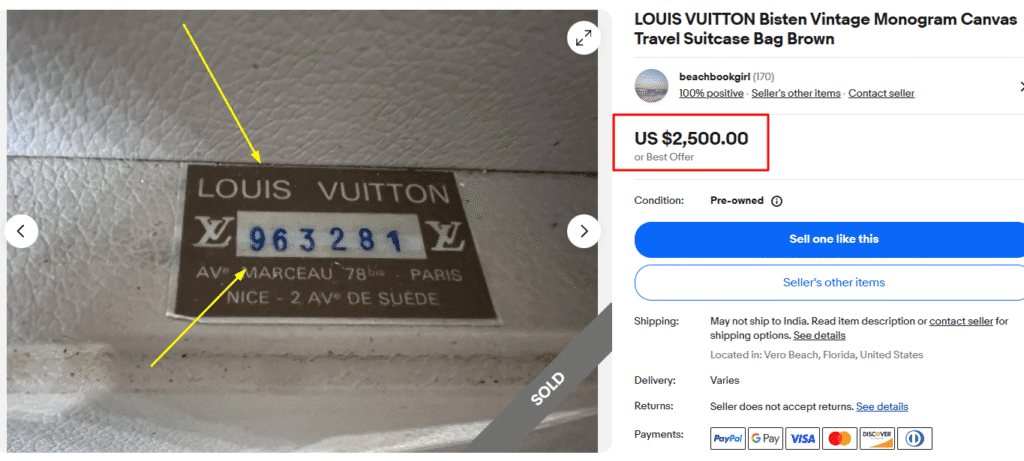
The easiest and most reliable way of spotting a vintage suitcase is by checking the marks on it. Most old suitcases bear different types of markings that will tell you plenty about their age and origin.
These marks can appear in various forms and locations, such as:
- Brand Labels/Plaques: Often seen on interior lining, sometimes exterior (paper, fabric, metal).
- Embossed/Stamped Leather: Name stamped into leather, inside or out.
- Hardware Engravings: Logos or brand names on the locks, latches, buckles, and key fobs.
- Serial Numbers/Date Codes: These are mostly hidden inside pockets or stamped somewhere on the interior. These numbers can help pinpoint manufacturing year/factory (more common mid-20th century and later).
I’ve curated this table displaying the common markings found on vintage suitcases from some prominent brands.
| Brands | Key Marks | Where to Look |
| Louis Vuitton | “LV,” “Louis Vuitton Malletier” stamps, “Paris/Made in France,” Date codes (1980s+) | Interior panels, Hardware (locks, clasps), Leather tags, Canvas |
| Samsonite | “Samsonite Luggage,” “Shwayder Bros., Inc.,” “Made in USA” common | Interior labels, fiber/plastic, Hardware |
| Hartmann | “Hartmann” logo, “Hartmann Luggage/Trunk Co.” “Belting Leather” | Labels, Brass plaques, Stamped leather, Hardware |
| Goyard | Hand-painted chevron pattern, “Goyard” stamp, “Goyard Paris,” or address, Serial numbers | Interior leather tags, Near opening, Hardware |
| Hermès | “HERMÈS PARIS MADE IN FRANCE,” Date stamps (letter in shape), signatures | Stamped interior leather, Near handle area, Hardware |
Note: The mark details shared above are based on several documented examples. Some differences may occur as the original markings can vary from piece to piece!
Design Details
From the corners to the tops, the design features of old suitcases changed with time, with each significant era leaving its unique clues. Understanding these features will help estimate the age of your suitcase. Here’s how:
- Late 1800s – Early 1900s (Victorian): If the suitcase feels heavy and boxy with leather/vulcanized fiber and brass hardware, it’s likely a pre-1920s piece. You’ll see reinforced corners, multiple straps, ornate interiors, and hand-painted family crests.
- 1920s – 1930s (Art Deco): If you observe quite streamlined shapes with sleeker leather build and geometric patterns on the body and hardware, you’re looking at an Art Deco suitcase. These also feature early synthetic elements and silk/patterned linings.
- 1940s – 1950s (Mid-Century): More modern and quirky, these suitcases will have lighter materials and functional designs with Industrial-style handles/clasps and bolder colors. The use of Samsonite’s molded plastic (Samolite) is a defining characteristic.
- 1960s: If you see lighter vinyl exteriors with diverse colors and contemporary patterns and simpler, modern hardware, it’s a retro suitcase from the 1960s or later.
Travel Stickers
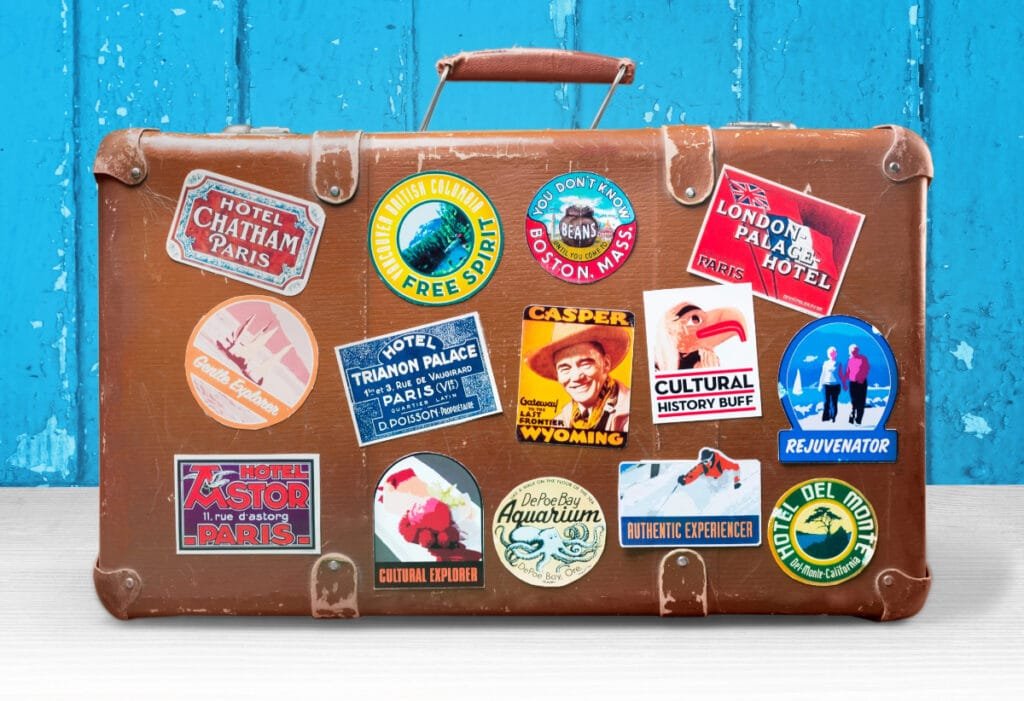
Hotels, airlines, and even national parks used to slap their stickers on travelers’ luggage as advertising. It’s also a sign of the places you (and the suitcase) have been. These travel stickers can verify whether an old suitcase is really vintage or not.
But even stickers can be tricky to spot, so pay attention! Real stickers look faded, worn, and stuck on properly from years of being there. Stickers that look too perfect or freshly slapped on could be fake!
What Makes an Antique Suitcase Valuable?
So now we know what vintage suitcases look like. But are they actually worth anything?
The answer is, yes! Generally, the value of old suitcases can range from $50 to $ 5,000 or more, depending on several crucial factors, apart from condition. Here’s a breakdown of these factors:
Condition
Just like any other old item, condition significantly drives the value of vintage suitcases; pieces in excellent or near-mint condition can fetch significantly more than the same examples in worn condition.
So, assess your luggage rightly. If you notice the following features, you’re looking at valuable stuff:
- Original patina and gentle aging
- All hardware is intact and still works
- The interior lining is clean and intact
- Minor scuffs that add character
On the other hand, cracked and dry leather that’s falling apart, and major structural damage are big red flags in terms of value. Missing or broken hardware and musty odors may also detract from the value.
Restoration is another important aspect you should consider. While minor professional repairs are okay, collectors generally do not prefer extensive or irrelevant restoration or repair.
My Tip: Remember, not every sign of wear and tear is harmful. Collectors love original patina and light scuffs on antique suitcases as signs of natural aging!
Rarity & Uniqueness
Now, some vintage suitcases are just harder to find than others, which naturally drives up their price. It’s simple – the rarer a vintage suitcase, the more desirable and valuable it is!
And here are the things that indicate whether or not it is rare:
Limited Edition Pieces:
Suitcases that were made only for a limited time or in limited numbers will be rare. These could be experimental designs, special releases for events (like an exposition or anniversary), or simply models that didn’t sell well and were quickly discontinued.
Similarly, pieces designed for specific audiences, markets, or stores are highly desirable. But documentation or verification is a must to prove rarity.
Discontinued Materials or Patterns:
Suitcases featuring materials, colors, or patterns that are no longer in production or use are super rare. For example, Louis Vuitton and Goyard used historical canvases and leathers that are no longer produced, making these bags highly sought-after!
Likewise, specific exotic leathers (like certain types of crocodile, elephant, or shagreen) are a big deal. Hermès used these rare materials in their vintage travel cases, making them super collectible!
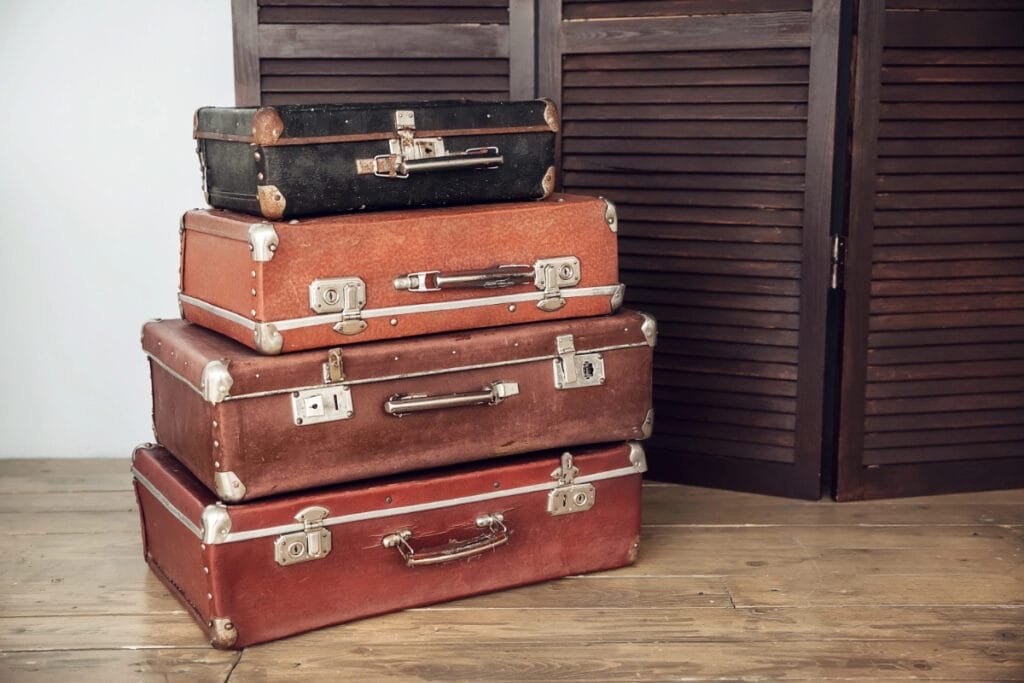
Early Innovations:
The very first iterations of new designs, like one of the earliest designs for a flat-top steamer trunk by Louis Vuitton (revolutionizing travel), or a pioneering suitcase with wheels, can be historically significant and, hence, rare.
Besides, early examples of a model that later went into mass production, or experimental designs that never made it to mass production, are also considered rather rare!
Brand Value:
Needless to say, vintage suitcases and luggage sets from high-end luxury brands like Louis Vuitton, Goyard, Hermès, and early Gucci are more desirable and command premium prices!
So, to assess an old case’s value, make sure to trace its tags and labels to find out its manufacturer.
Provenance & Backstory
If a suitcase belonged to or is associated with someone famous, went on an iconic trip (like the Orient Express or a legendary ocean liner), or has a well-documented backstory, its value can skyrocket!
For example, Amelia Earhart had her own luggage line in the 1930s. It was marketed as “real airplane luggage,” and pieces from that line can be collectible today.
Also, high-end houses like Louis Vuitton, Goyard, and Hermès let clients order completely custom pieces. These often had unique materials, color mixes, personalized interiors (like specific drawer setups, hidden compartments), or custom monograms on them!
These “bespoke” items are often one-offs or made in extremely small numbers, making them the ultimate in rarity!
Documentation & Original Accessories
Original documentation and accessories can affect an old suitcase’s worth more than you think! So, check if the suitcase has the following:
- Original Keys: Still having the actual key(s) for a suitcase’s lock is a huge plus. Make sure the keys aren’t forged!
- Dust Bags/Covers: For high-end brands, keeping the original dust bag shows the owner cared and helps prove it’s authentic.
- Paperwork: Any original receipts, care guides, or product tags can boost value and help confirm its origin.
Special Features
The most valuable vintage suitcases often came with unique features that are hard to find in other cases from that period.
To assess the value, look for the following features:
- Fitted Toilet Cases: High-end pieces came with crystal bottles, silver-topped containers, and brushes all nestled in custom-cut compartments.
- Wardrobe Compartments: Suitcases folded out and often had several compartments, unlike modern clamshell styles. The cases featured multi-compartment packing devices with attachments for hat boxes and hidden pockets for valuables.
- Fitted Wardrobe Compartments: Vintage suitcases often came with fitted internal setups like hat boxes, shoe sections, fitted vanity kits, or secret drawers.
- Innovative Mechanisms: Early versions of wheeled luggage (even though they didn’t catch on until much later), folding designs, or clever locking systems can add serious value to a piece.
8 Examples of Rare Vintage Suitcases Worth a Lot of Money!
Below are a few examples of vintage suitcases that are actually rare and valuable! The estimated prices of these items are based on completed sales!
1. Louis Vuitton Bisten Monogram Brown Suitcase
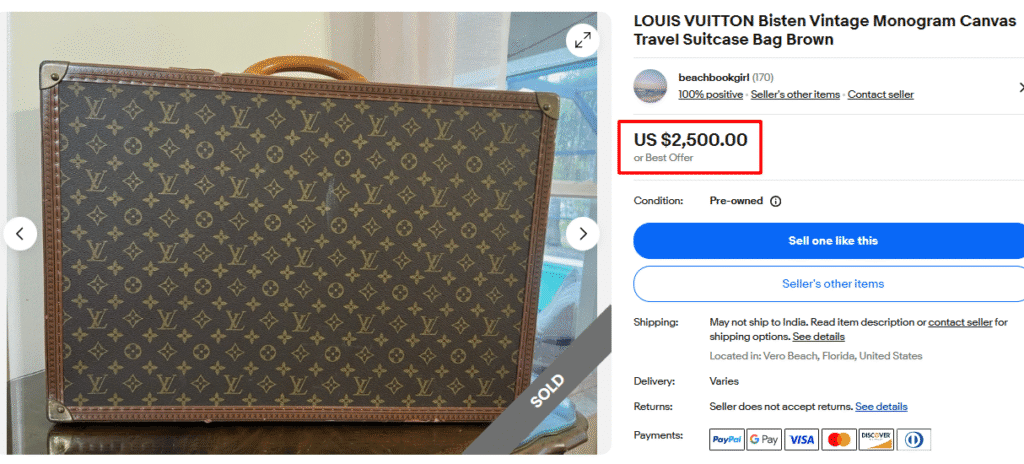
A vintage Louis Vuitton suitcase is every collector’s dream! The piece is from LV’s Bisten line, comprising some of the finest travel cases ever made! You can spot these suitcases by the iconic monogram canvas with leather trim!
These cases were handcrafted with solid brass hardware and reinforced corners, making them super durable. The iconic monogram pattern itself makes these luggage pieces highly desirable.
Vintage Bisten suitcases generally range from around $200 to over $5,000, depending on condition and size! Even with some wear, these LV pieces can be valuable!
2. Ralph Lauren Blackwatch Plaid Suitcase
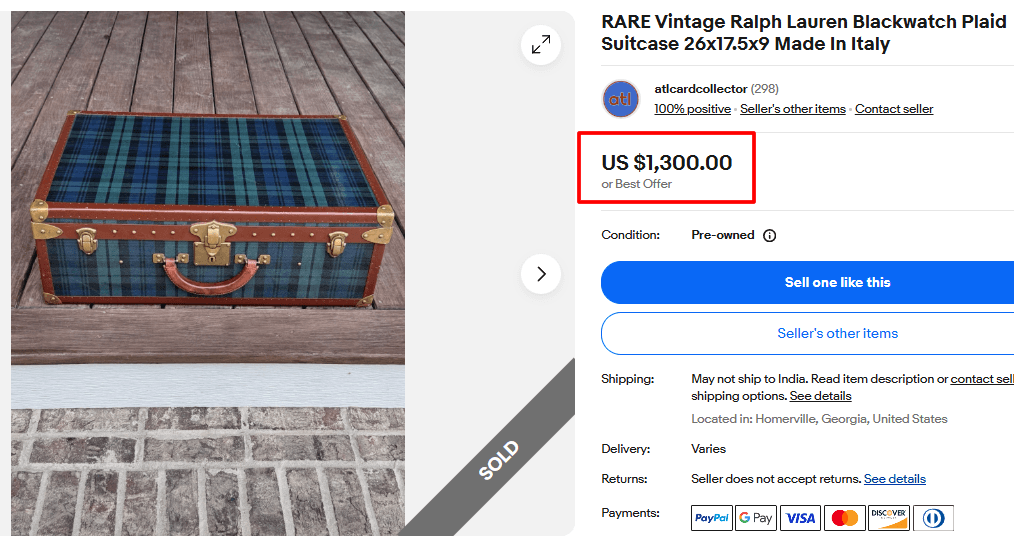
This preppy-style vintage suitcase with the iconic dark green and blue plaid, also known as Black Watch plaid pattern, from Ralph Lauren is a rare find! The tartan pattern is inspired by the historic Black Watch military regiment’s colors.
Clean leather corner reinforcements and brass hardware are signs of authentic BlackWatch suitcases. On the inside, you’ll see straps, buckles, and pockets. In good condition, like this example, these old suitcases can fetch $500-$2,000!
3. 1920s Hermes Paris Leather Trunk Suitcase
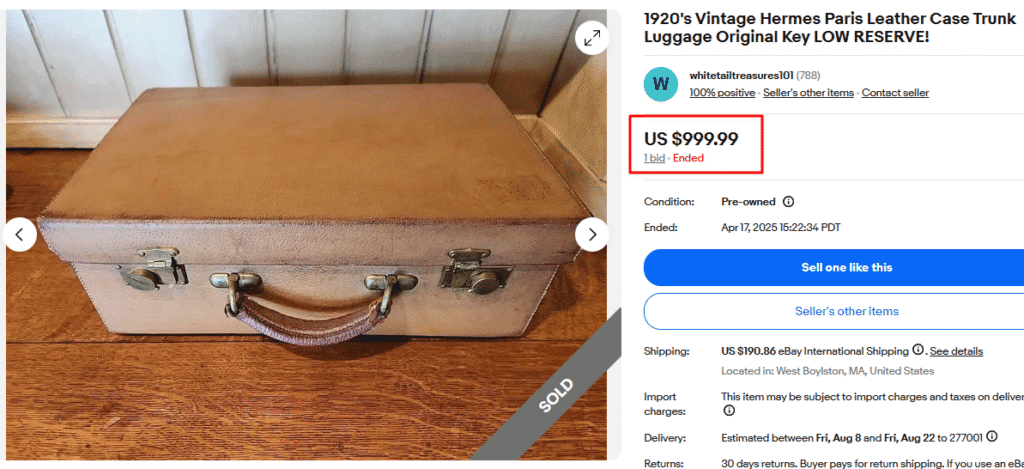
Hermès started making travel luggage in the early 1900s, and this 1920s trunk features its signature heavy brown pigskin leather construction (which was super tough) with brass locks stamped “Hermes Paris.”
This suitcase features the original brass hardware with reinforced corners and edging, a main leather handle. Inside the case, you’ll find many small compartments for easy storage and organization. While this piece sold for almost $1,000, mint-condition Hermès suitcases can fetch up to $3,000+!
4. Goyard Jacquard Canvas Suitcase
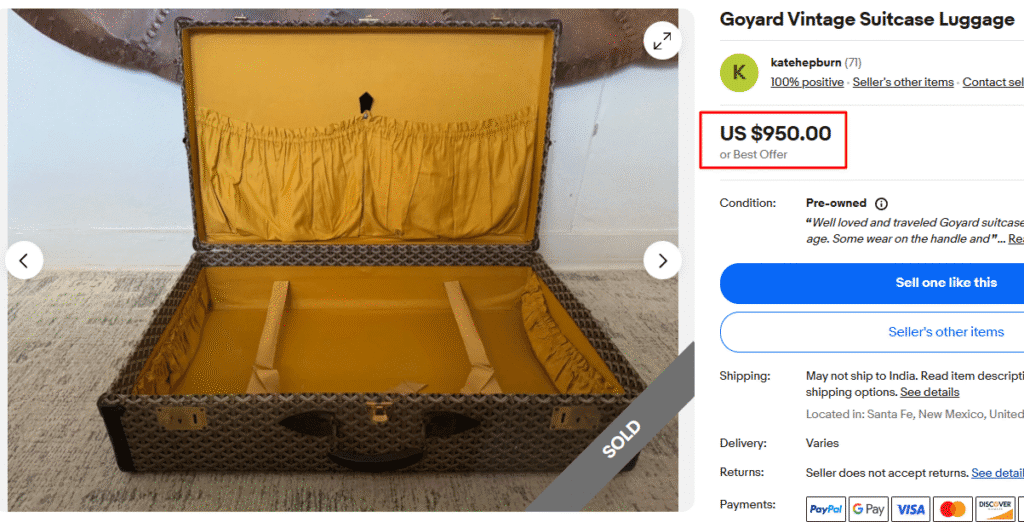
This stunning Goyard suitcase features the brand’s iconic chevron canvas pattern with a beautiful yellow fabric interior and leather straps. You can see the exceptional craftsmanship in the hand-painted canvas and solid brass hardware.
The suitcase shows an obvious rich patina, which authenticates it as a vintage piece. Besides, Goyard’s reputation for one-at-a-time craftsmanship is what makes this piece worth the price tag of $950! Mint condition Goyard pieces can fetch up to $5,000 or even more!
5. Retro Zero Halliburton Aluminum Suitcase
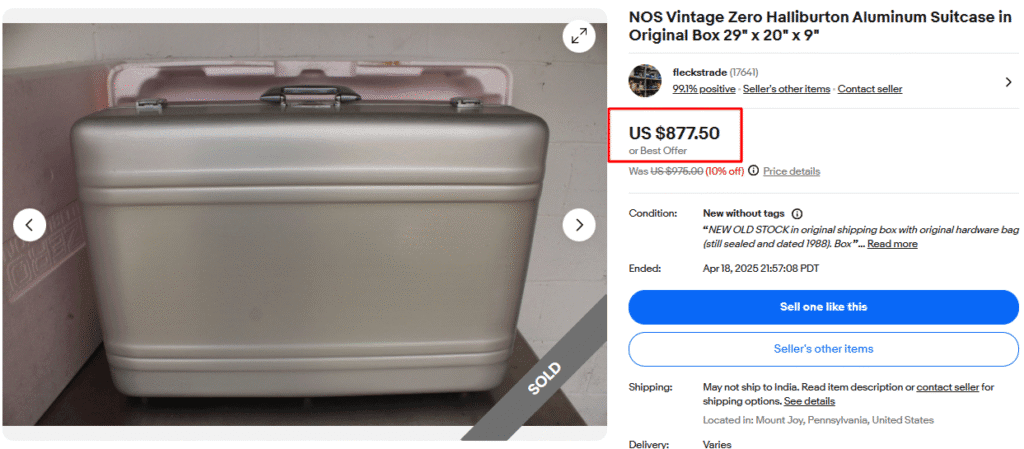
Although not really vintage, this piece made it to the list because of its unique build and historical significance. It’s an aluminium-shelled Zero Halliburton suitcase featuring the brand’s signature ribbed construction!
Aluminium cases like these became extremely popular in the 1980s due to their lightweight and easy-to-carry body. Thanks to mechanical advancements, these cases came with number locks for better safety.
Despite being relatively newer, these cases are desirable due to their popularity back in the day. Besides, it’s a “New Old Stock” piece with all its original packaging and tags, adding to its authenticity and value!
6. Innovation Trunk Company Crocodile Leather Suitcase
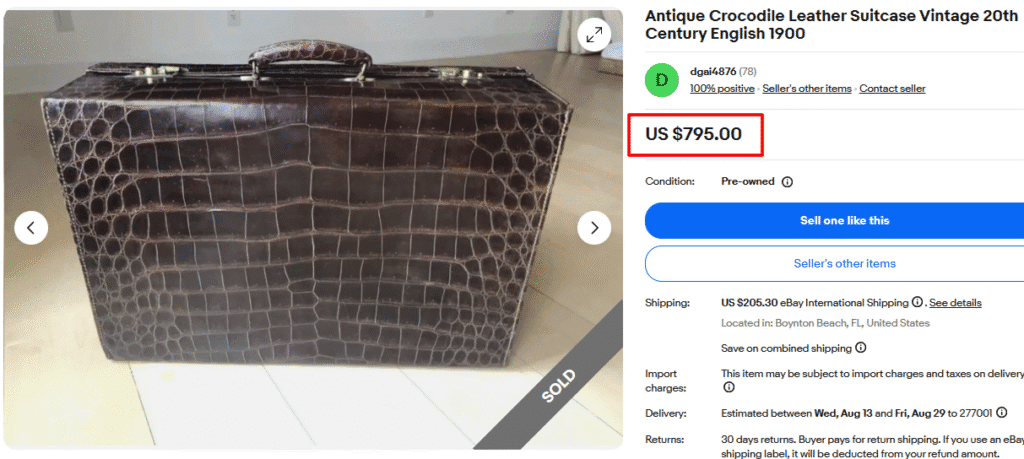
Back in the 1900s, specific leathers like pigskin leather and crocodile leather were a big deal! This suitcase from the English Innovation Trunk Company features a sturdy crocodile leather build, making it rare in itself.
Being a rare material, crocodile leather suitcases are highly desirable these days. You can find these anywhere from $500 to over $3,000, depending on the condition!
7. Hartmann 4700 Suiter Pullman Leather Suitcase
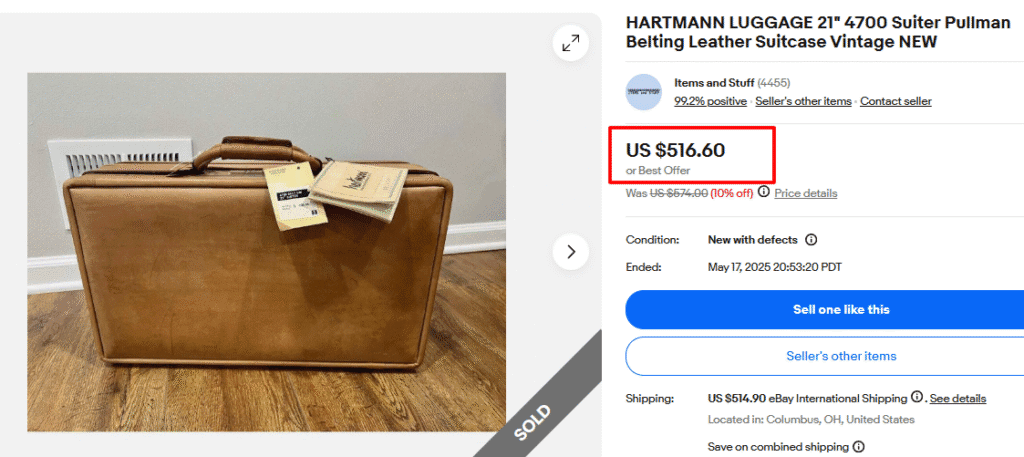
Hartmann made this “Suiter Pullman” line just for business guys who needed to travel without wrinkling their suits. It’s got the belted compartments for keeping the clothes and even a little bar inside to hang pants, and comes with the original hanger!
Also, these suitcases feature a specific type of leather they used to call “belting leather” – super tough stuff that’s made for rough use!
What makes this Hartmann suitcase worth the money is that it’s a “New Old Stock” piece – meaning it’s never been used and still has its original tags.
8. 1950s Samsonite Blue Luggage Set (Suitcase & Hat Box)
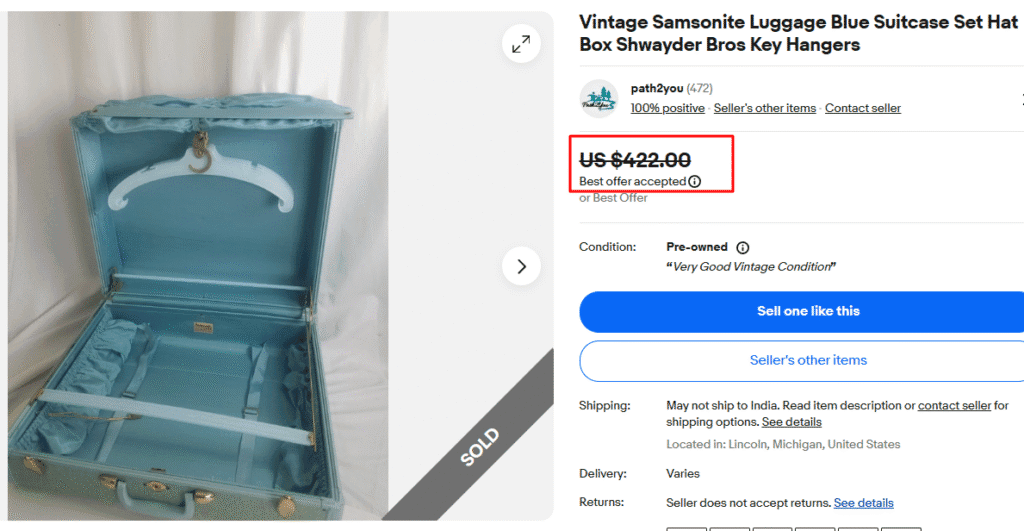
Vintage luggage pieces, especially full sets like this, in rare colors from renowned brands, are highly desirable. For example, this is a complete Samsonite luggage set of a suitcase, a round train case (hat box), and a carry-on clamshell case, all in robin’s egg blue color!
You’ll see original removable hangers, folding bars, expandable straps with brass buckles, and pockets inside the cases. That’s also where you’ll find the “Samsonite Luggage” labels. Samsonite is popular as America’s luggage powerhouse thanks to its durable travel cases!
Note: This article is intended for informational, educational, and entertainment purposes only. Some images are illustrative and may not represent actual brands, products, or related entities. All trademarks, product names, brand logos, packaging, and other intellectual property referenced remain the exclusive property of their respective owners. Any brand mentions or references are provided solely for descriptive and educational context and do not imply any formal or commercial association.


